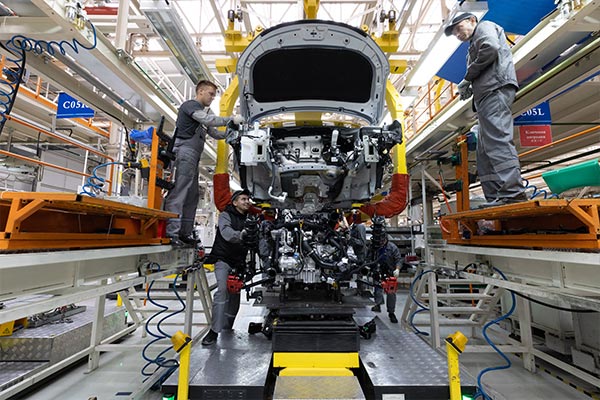Welcome to My Blog! 🌟
Before we dive into the content, I’d love for you to join me on my social media platforms. It’s where I share more insights, engage with our vibrant community, and post regular updates. Here’s how you can stay connected:
📘 Facebook: Connect with me on Facebook
Now, let’s embark on this journey together. I hope you find the content here insightful, engaging, and most importantly, valuable. Let’s explore, learn, and grow together! 🚀
Table of Contents
Introduction

Tool steel material has become indispensable in the automotive sector. As the tool steel market grows—from about USD 6.53 billion in 2024 to nearly USD 8.96 billion by 2029 (CAGR ~6 %)—automotive demand plays a major role in this expansion. With automotive applications requiring precision, durability, and heat resistance, tool steel material supports the manufacturing of components that must last under extreme conditions.
Shandong Qilu Industrial Co., Ltd., through Qilu Tool Steel Company, produces high-performance grades like P20, H13, D2, and S7—each tailored for different automotive needs. This article explores five strategic uses of tool steel material in automotive engineering, supplementing each with recent industry trends and customer case studies.
1. Engine Component Manufacturing: Wear Resistance and Heat Tolerance
Modern automotive engines operate under extreme pressure and high thermal conditions. Components such as valve guides, piston pins, cam followers, and timing gears must maintain dimensional integrity and mechanical properties despite exposure to continuous friction and cyclic temperatures. That’s where tool steel material like D2, D3, and A2 demonstrates exceptional value.
D2 tool steel is renowned for its high carbon, high chromium content, making it ideal for resisting abrasive wear. Its stability under heat is critical in preventing deformation and maintaining part tolerances over time. D3 offers similar benefits, with slightly higher wear resistance and surface hardness, while A2 provides a balance of toughness and machinability, making it suitable for larger or more complex shapes.
Real-World Example: EV Powertrain Upgrade
A prominent Chinese electric vehicle (EV) manufacturer transitioned from medium-carbon steel to D2-grade tool steel for its transmission and gear housing components. The result? An 18% drop in part failure rates, reduced component deformation, and maintenance intervals extended by more than 20,000 kilometers per service cycle. This material change significantly reduced downtime and total lifecycle cost.
Additionally, A2 has been adopted in high-performance motorcycle engines for its resistance to distortion during cold starts and high-speed operation. When used in valve train guides and lifters, it shows lower wear rates and reduces the need for early part replacement.
These tool steel materials are not just prolonging part life; they’re helping automakers meet strict durability benchmarks required in today’s electric and hybrid drivetrains.
2. Chassis & Suspension: Shock-Tolerance and Structural Integrity

Chassis and suspension systems endure dynamic forces—vibrations, impacts, and oscillating stresses—on every journey. Tool steel material grades such as H11, H13, and M2 are excellent choices for components such as control arms, suspension brackets, cross-members, and torsion bars.
H13 is widely recognized for its chromium-molybdenum-vanadium composition, granting superior thermal stability and impact resistance. It’s ideal for parts subjected to repeated shock and bending, especially in rugged terrains or performance vehicles.
Real-World Example: High-Stress Suspension Redesign
A German automotive OEM, known for its high-speed track vehicles, substituted H13 tool steel into its suspension bracket systems. Rigorous test simulations showed a 30% increase in service life during aggressive cornering and dynamic load scenarios. M2, often used in tool bits and cutting machinery, was adapted for load-bearing suspension bolts—resulting in reduced microfracture formation after prolonged exposure to vibrations.
These successes prove that chassis strength isn’t just a product of geometry—it’s rooted in choosing a tool steel material that delivers the necessary toughness, fatigue resistance, and long-term reliability.
3. Brake & Safety Mechanisms: Strength Under Thermal Stress
Brake systems are among the most critical safety elements in any vehicle. During deceleration, components like brake pads, calipers, backing plates, and anti-lock braking systems (ABS) endure rapid thermal fluctuations and mechanical stress. Tool steel material such as M4 and M7 is engineered specifically for such harsh environments.
M7 tool steel is prized for its high-speed steel (HSS) capabilities—retaining hardness at elevated temperatures exceeding 500°C. Its fine-grain structure minimizes thermal fatigue cracking and ensures performance during high-friction braking.
Real-World Example: Aerospace to Automotive Crossover
An aerospace supplier pivoting into automotive component manufacturing adopted M7 tool steel in brake insert molds for high-speed performance cars. After integration, thermal distortion decreased by 25%, improving pad alignment and extending rotor life. M4 showed exceptional high-temperature wear resistance when implemented in ABS sensor carriers, ensuring sensor alignment and reliability in emergency braking conditions.
In both performance and daily-use vehicles, these tool steel materials protect lives by offering mechanical stability, thermal resilience, and reliability under pressure.
4. Mold Making for Automotive Parts: Precision and Fatigue Resistance

Injection molds, die-cast tools, and stamping dies form the backbone of automotive part fabrication. From interior components like dashboards and air vents to exterior body panels, achieving fine detail and dimensional stability is essential. Tool steel material grades like P20 and H13 are industry standards in this space.
P20 is a pre-hardened mold steel with good machinability and excellent polishability. H13, also used for hot work applications, offers resistance to thermal fatigue and cracking under repeated heating and cooling cycles—perfect for high-volume production environments.
Real-World Example: Door Panel Mold Success
A global Tier-1 supplier integrated P20 tool steel molds for its door panel production lines. The result: a 40% reduction in defect rates, minimized mold maintenance, and faster production cycle times. H13, when used in die-casting molds for aluminum parts, prolonged mold service life by 30%, reducing unplanned line stops in automated plants.
These materials contribute not only to the efficiency of the manufacturing process but also to the precision and appearance of the final product, making them vital for brand image and consumer satisfaction.
5. Structural Safety Components: Energy Absorption in Collisions
When collisions occur, passive safety components must absorb energy efficiently and maintain structural integrity to protect vehicle occupants. Components such as side-impact beams, bumper reinforcements, and roof pillars rely on tool steel material like S7 and D6 to manage high-impact scenarios.
S7 is designed for shock resistance, with excellent ductility and the ability to resist deformation. D6, a high-carbon, high-chromium tool steel, exhibits outstanding wear resistance and maintains form during high-stress impacts.
Real-World Example: Crash-Test Validation
A crash simulation conducted by an international safety testing agency showed that door beams made with D6 steel absorbed 15% more energy during side-impact testing compared to conventional alloy steel. In another project, S7 was used in bumper cores for an electric SUV, where its flexibility and toughness improved crash survivability without adding weight.
These grades are playing a crucial role in meeting ever-tightening global safety standards such as Euro NCAP and NHTSA—ensuring that structural integrity is preserved during extreme impact scenarios.
Mid-Article Table: Comparison of Automotive Applications
| Application Area | Tool Steel Grades Used | Key Properties | Real‑World Benefit |
|---|---|---|---|
| Engine Components | D2, D3, A2 | Heat resistance, wear resistance | Lower replacement frequency, stable precision |
| Chassis & Suspension | H11, H13, M2 | Toughness, fatigue resistance | Enhanced durability under repetitive stress |
| Brake & Safety Mechanisms | M4, M7 | Thermal stability, tensile strength | Less warping, more reliable performance |
| Mold Manufacturing | P20, H13 | Precision machining, thermal fatigue | Reduced defects, faster cycle times |
| Structural Safety Components | S7, D6 | Shock absorption, strength | Better crash performance, controlled deformation |
Market Insights: Why Tool Steel Material Demand Is Rising in Automotive

The automotive tool steel market is estimated at USD 2.67 billion in 2024 and projected to grow to USD 3.41 billion by 2033 (CAGR ~3.1 %). Asia-Pacific leads global growth, with the fastest increase expected across Europe and North America.
Technological advancements—such as powder metallurgy, plasma nitriding of H13, and AI-based heat treatment—also boost performance and fuel adoption of premium tool steel material.
Conclusion
From high-wear engine parts to crash-safe reinforcements, tool steel material provides strength, precision, and reliability. Shandong Qilu Industrial Co., Ltd. continues to support automotive innovation by supplying world-class grades like P20, H13, D2, S7, and more. Our rigorous quality control, R&D innovation, and customized engineering ensure that each grade meets the safety and performance demands of modern vehicles.
FAQ
What is tool steel material and why is it essential in cars?
Tool steel material refers to high-carbon, alloy steels designed for hardness and wear resistance, essential for parts exposed to stress and heat in vehicles.
Which tool steel grades are commonly used in auto engine parts?
D2, D3, and A2 are widely used for engine applications due to their durability and resistance to wear and heat.
Can tool steel material be used in electric vehicle manufacturing?
Absolutely. EV production’s precision needs align well with tool steel grades like H13 and P20 for molds and chassis parts.
How do market trends affect tool steel material choices?
Increasing demand for lightweight, durable, and sustainable parts drives innovation, while growth in Asia-Pacific accelerates volume and performance requirements.
Why choose Qilu for tool steel material supply?
Qilu Tool Steel Company delivers premium steel tailored for automotive clients, backed by German-imported equipment, an experienced R&D team, and strict process control.
Interested in optimizing your automotive parts with state-of-the-art tool steel material? Contact Shandong Qilu Industrial Co., Ltd.—our experts will provide tailored solutions and support for your next project.

